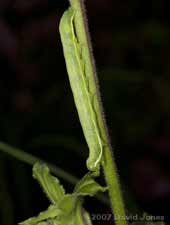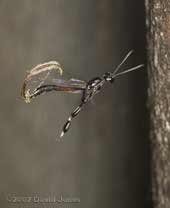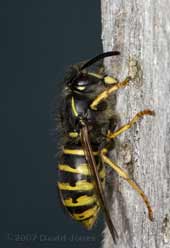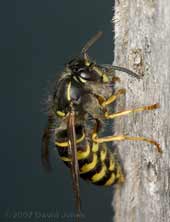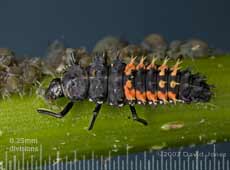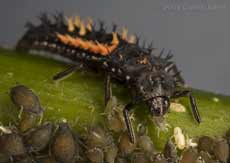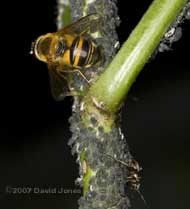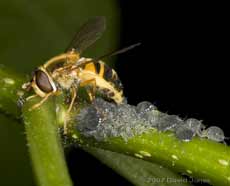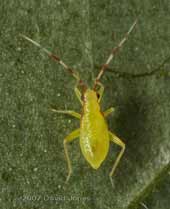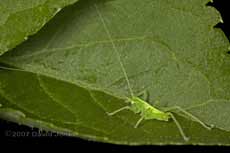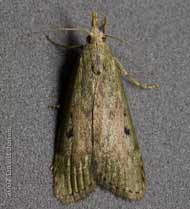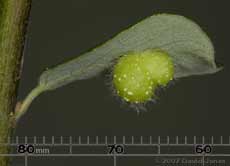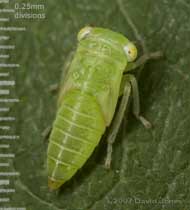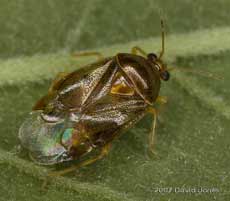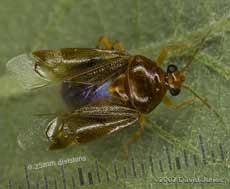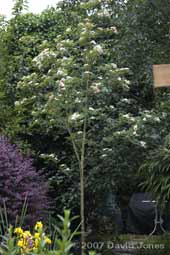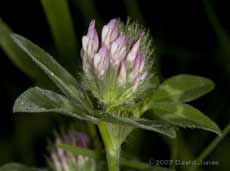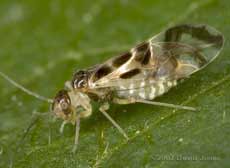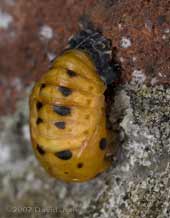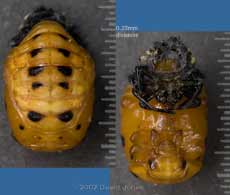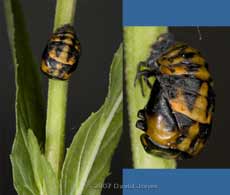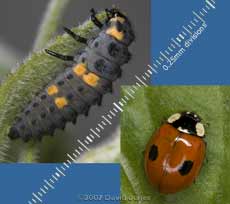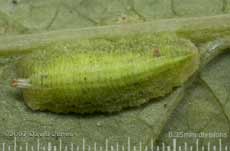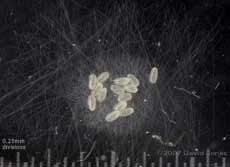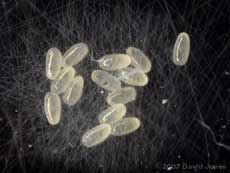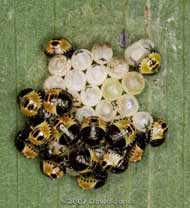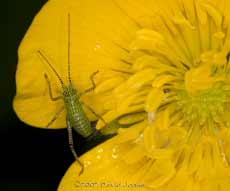Go to the last entry on this page .....Go to previous entry25-28 May - On the day we came home from Mudeford (see previous page), temperatures were well in excess of 20C. Since then they have dropped each day, and today (28th) it has been below 6C for most of the day, with rain almost non-stop for the last two days. As a measure of how much rain there has been, one of my tree surgeon sons has sent me a picture of a mature Horse chestnut tree that fell over onto his garage this morning (from neighbouring land)! At least the rain is making me stay inside and take things easy. It's very frustrating to go away for a rest, only to feel shattered when you get home. I've taken a few pictures since coming home but this evening is the first time I've been able to keep going long enough to get some diary done. From the 25th -
This caterpillar was responsible for the demolition of the entire top of a Ragged Robin stem, flower buds included, and seemed to be using the stem as a base to reach out to what ever foliage was nearby.
The bee hotels were being visited by this single Gasteruption jaculator, a parasitic fly that is a regular visitor in June. This individual seems to have a problem with its ovipositor which may be tangled up with spider web silk.
Another visitor to the bee hotels wasn't interested in the bees, but in the timber itself. This wasp (the only one to be seen for several weeks) busied itself nibbling off wood to use in the construction of a nest. Look above the wasp and you can see a darker, rough area left behind as the wasp works down the wood.
In this second shot, the wasp is tucking the ball of wood pulp under its 'chin' before flying away.
Some time back I took some photographs of Harlequin Ladybird larvae hatching out. Before we went away I took the decision to destroy all but one of the larvae just in case that were released accidentally. That one larva is now a large and unmistakeable individual, and I have yet to find any 'wild' examples in the garden.
It was photographed with aphids on a short length of Elder stem, removed during a bit of pruning. When I loaded this second image into the computer, I saw that there was a white egg amongst the aphids.
Later, I spotted this hoverfly moving between groups of aphids on the Elder,
and realised that it was egg-laying. Although I didn't actually see an egg being laying, in this picture you can clearly see that the hoverfly's ovipositor is extended in between the aphids. Could the egg in the earlier picture have been laid by a hoverfly?
The elder cuttings also revealed two 'regulars'. First of all, numerous of these little bug nymphs with their obvious red stripes,
and a couple of these cricket nymphs. I have yet to identify either species.
Under the Birch tree I've spotted my first bush cricket nymph of the year, although it wasn't interested in staying put for a photograph. Late that evening we had a moth visitor in the house (I'm seeing hardly any in the garden). I think it's a Snout or a Fan-foot but I'm still trying to identify it. None of the examples in my moths book have the definite green tinge that this one exhibits. Thanks to Richard Clark of London I now know that it is actually a micro-moth, a Bee Moth (Aphomia sociella), and the green tinge indicates that it is a female.
Yesterday (27th) I used my extending secateurs to reach across the big pond to lop off a couple of Willow branches , and those branches yielded a few things to record.
First, a couple of galls,
a little frog-hopper or Plant-hopper nymph,
and finally, a very small, adult bug which is still waiting to be identified.
In this second picture I was lucky to catch it as it opened up its partially hardened front wings to reveal the iridescence of its hind wings.
On the plant front, the Rowan flowers are fading already, with many of them turning brown over the last few days - the same is true of the Pyracantha blossoms by the veranda.
The wild flower plants that I planted on 10 May have started to produce flowers, at least the Primrose, and the Red Clover have, the latter opening a couple of days ago.
In the cold wet conditions, the bird feeders have been busy today, with numerous Starling fledglings crowding the table, and fledgling Blue Tits and Goldfinches getting fed. There are also Great Tits back and forth, but I haven't seen them feeding offspring. There is a lot of chirping going on around the garden so it's possible that they have youngsters hidden away elsewhere here.
29 May - With the bank holiday over, the sun returned today, helping the temperature to reach 16C for a very short time this afternoon. The large images for both the previous entry, and our Mudeford trip have now been added
There are quite a few barkflies in the usual places around the garden, most obviously underneath bamboo leaves. I shall have to watch out for 'new' species to record. There is now a National Barkfly Recording Scheme for these small and often inconspicuous insects. Thanks to Bob Saville, who is the organiser of the recording scheme - he has identified the Barkfly as Graphopsocus cruciatus, one of the picture-winged species. Our front garden has been a bit of a disaster for quite some time now while it waits for us to decide how to allow for car parking and at the same time ensure that there are plenty of plants available for insects. This afternoon I spent a while doing some weeding out there, and as usual needed to check each plant as it was removed (no spraying!!).
Before I started, I spotted this large ladybird pupa attached to the brickwork of my neighbours' garden wall. It was in a vulnerable spot so I removed it to a safe place on my veranda so that I can (hopefully) see the adult emerge in the near future. I'm in a dilemma as to what species it is - is it a 7-Spot Ladybird, or a Harlequin. The
Removing it from the wall has allowed me to see the side of it normally hidden from view. You can see details of things like the axe-shaped palps, and the final larva skin, crumpled up around the point of attachment. In the right-hand image you can see what had been the legs of the larva. The skin doesn't seem to be 'spiky' enough to be a Harlequin, and there are not enough light coloured 'spikes', so I suspect that it is a 7-spot.
On one of the Willowherb plants that I pulled out there was another, similar sized pupa. This matches much more closely the illustration of a 7-spot Ladybird pupa in 'Ladybirds of Surrey'.
On another plant was this single larva of a 7-Spot Ladybird, although in this picture I have included a 2-Spot Ladybird, found on the same plant and photographed at the same magnification so that you can compare their sizes.
Finally, there were two of these larvae on Sow-thistle leaves, and which I believe are probably hoverfly larvae, although I do not have any idea as to the species.
Despite the blue skies, not only do the House Martins remain away, but I neither saw or heard any Swifts today!
30 May - Another damp day, at least until the middle of the afternoon when the clouds broke up and the sun came out and helped lift the temperature up to nearly 16C. No pictures from the garden today, but my forgetfulness last night was rewarded by an interesting subject to photograph tonight. Yesterday, in order to photograph the underside of the barkfly I put it into an arrangement between two sheets of photographic quality glass. However, By the time I had finished it was very late, I was tired, and I forgot to release the fly.
It was only at 10pm tonight that I realised my mistake, but rather than suffering in captivity, the barkfly (Graphopsocus cruciatus) had been busy. She had built her equivalent of a nest and laid 14 pearly white, almost transparent eggs, each measuring just under 0.5mm in length.
I have seen the silk structures before on leaves in the garden, but this is my first opportunity to see the 'nest' in detail. As far as I can make out it consists of two distinct structures. First there is the almost circular dense mat of silk on which the eggs are laid. These are then enclosed in a must looser matrix of longer silk strands. look at the egg on the right and you can clearly see a strand passing over it.
Tomorrow morning I will transfer the piece of glass to a larger container (a petri dish) and keep an eye on them as they develop. From what I've seen on the bamboo plants in the garden, the adults seem to stay with their eggs and youngsters so I shall probably put her into the container as well, although I will need to sort out feeding arrangements for her.
31 May - We end the month on a somewhat brighter note, with sunny spells, the breeze from the south-east, a high of around 19C, and only a bit of dampness this morning. Unfortunately there's still no sign of the House Martins - and where have the Swifts gone?
Back on the 2nd I photographed some insect eggs that had appeared that day on an Iris leaf. Today they been hatching, revealing shieldbug nymphs. Originally there were 28 eggs, of which at least two have disappeared, and this afternoon I can see 15 nymphs. I'll count again tomorrow.
Also photographed on the 2nd was a pendulous egg case which is still intact today, and one of numerous larvae found under folded lobes on oak leaves. I photographed these again on the 18th, but yesterday I noticed that all the larvae had disappeared. There is no sign of pupae on the plant so I'm wondering if they have headed under the soil to pupate.
A few days ago I mentioned seeing my first bush-cricket of the year - this afternoon I spotted this second example on a buttercup. With its spotty, and rather stubby appearance, this is so different to the cricket nymphs that I see on the Elder.
Click on images to see larger versions |
|
